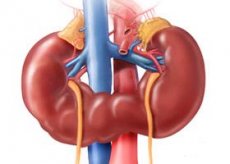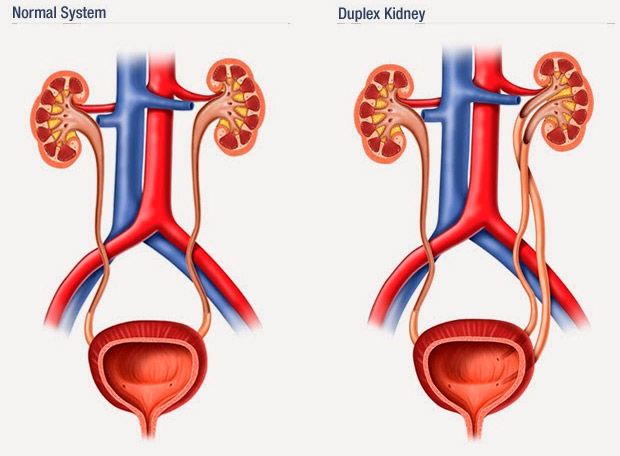Kidney doubling
Last reviewed: 23.04.2024

All iLive content is medically reviewed or fact checked to ensure as much factual accuracy as possible.
We have strict sourcing guidelines and only link to reputable media sites, academic research institutions and, whenever possible, medically peer reviewed studies. Note that the numbers in parentheses ([1], [2], etc.) are clickable links to these studies.
If you feel that any of our content is inaccurate, out-of-date, or otherwise questionable, please select it and press Ctrl + Enter.

Causes of the kidney doubling
Kidney doubling occurs when two centers of differentiation induction are formed in the metanephrogenic blastema. In this case, two cup-pelvis system is formed, but complete separation by the blast does not occur, and therefore the kidney is covered with a common fibrous capsule. Each half of a double kidney has its own blood supply. The renal vessels may depart separately from the aorta, or they may be separated by a common trunk, dividing at the renal sinus or nearby. Some intrarenal arteries pass from one half to the other, which can be of great importance in resection of the kidney.
Symptoms of the kidney doubling
Most often underdeveloped is the upper half, very rarely both halves are functionally the same or the lower half is underdeveloped. Underdeveloped half in its morphological structure resembles kidney dysplasia. The presence of parenchymal renal dysplasia in combination with urodynamic disorders due to cleavage of the ureter creates the prerequisites for the occurrence of diseases in the abnormal kidney.

Most often, kidney doubling symptoms duplicate the symptoms of the following diseases: chronic (53.3%) and acute (19.8%) pyelonephritis, urolithiasis (30.8%), hydronephrosis of one of the halves (19.7%). Suspected doubling of the kidney can be with ultrasound, especially with dilatation of the upper urinary tract.
Where does it hurt?
Forms
Additional (third) kidney
The accessory (third) kidney is one of the rarest abnormalities of this organ. Defect is almost always one-sided. Its origin is similar to the genesis of kidney doubling, but too rapid differentiation leads to a complete separation of two metanephrogenic blast and the formation of two kidneys. The accessory kidney always has its own fibrous capsule, the blood supply system, the calyx-pelvis system and the ureter, often opening with an additional third mouth in the bladder below and medial to the two main orifices, but it may merge with the ureter of the main kidney (ureter fisus).
Diagnostics of the kidney doubling
Excretory urography helps diagnose kidney doubling. However, the most difficult task is the determination of complete or incomplete doubling. The use of magnetic resonance urography and MSCT greatly simplifies this task, but does not solve it completely. The presence of ureterocele is a factor impeding the diagnosis of complete or incomplete doubling of the kidney. Cystoscopy in most cases helps to establish the diagnosis.
Diagnosis of accessory kidney
With the development of highly informative methods of ultrasound and radiology (ultrasound, spiral CT, MRI), the number of observations of the accessory kidney is increasing. The most common disease in the case of an additional third kidney is hydronephrosis.
What do need to examine?
How to examine?
What tests are needed?
Who to contact?


 [
[